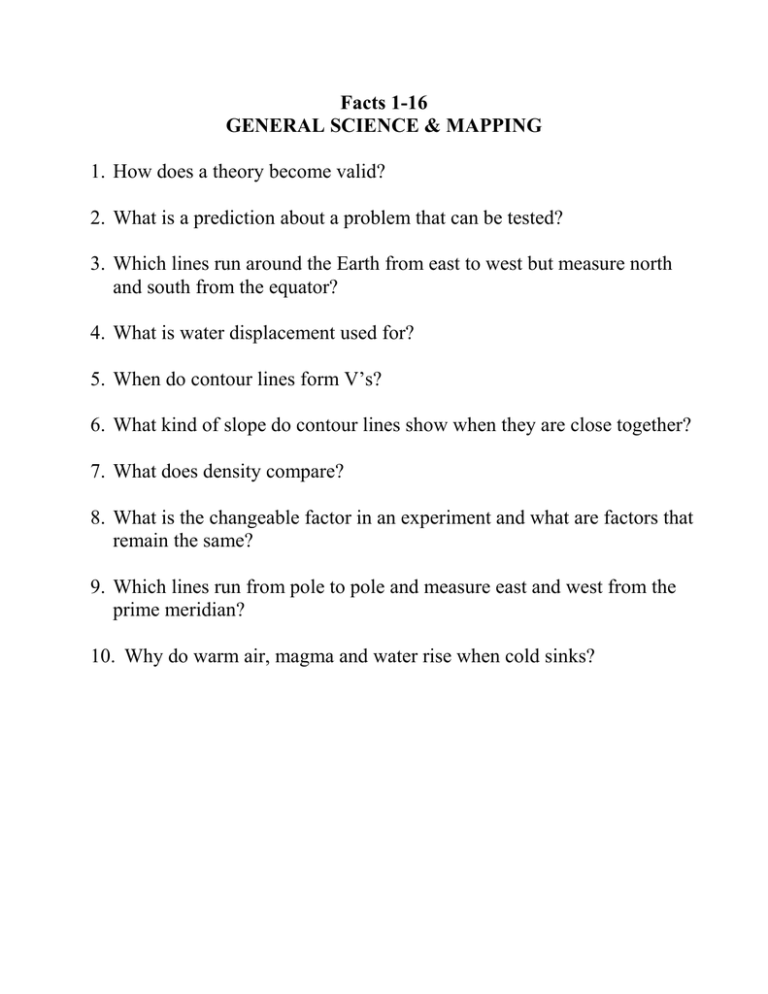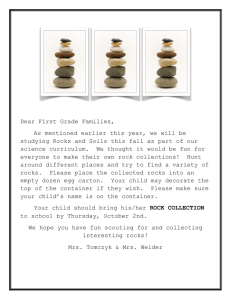Facts 1-16 GENERAL SCIENCE & MAPPING
advertisement

Facts 1-16 GENERAL SCIENCE & MAPPING 1. How does a theory become valid? 2. What is a prediction about a problem that can be tested? 3. Which lines run around the Earth from east to west but measure north and south from the equator? 4. What is water displacement used for? 5. When do contour lines form V’s? 6. What kind of slope do contour lines show when they are close together? 7. What does density compare? 8. What is the changeable factor in an experiment and what are factors that remain the same? 9. Which lines run from pole to pole and measure east and west from the prime meridian? 10. Why do warm air, magma and water rise when cold sinks? Facts 17-33 PLATE TECTONICS 1. Which seismic waves travel the fastest? Which type of wave only travels through solids? 2. Which type of crust is made of basalt, thin and young? 3. How many seismic stations are needed to find the epicenter of an earthquake? 4. What do convection currents do? 5. Why will an ocean plate always sink under a continental plate? 6. What type of boundary creates mountains, subduction zones, trenches & faults? 7. Volcanoes and Earthquakes mark the locations of what? 8. What type of boundary creates mid-ocean ridges and rift valleys? 9. What type of boundary creates strike slip faults and earthquakes? 10. What is a break or crack in the Earth’s crust where movement has occurred? Facts 34-44 WEATHERING & EROSION 1. During sedimentation (deposition), what size particles settle out of water first? 2. What is the process by which Earth materials are transported by moving water, ice, or wind? 3. What is the process that rocks are broken down by water, ice and organisms? 4. Ice Wedging is an example of what type of weathering which breaks rocks into smaller pieces? 5. How does soil evolution begin? What material must be present in order to have soil? 6. What is the term for he dropping or settling out of sediment? 7. List the 3 horizons of a soil profile. 8. What type of weathering occurs in warm, humid environments where a rocks composition is changed into a new material (like limestone turning into clay)? 9. What are the major agents of erosion? 10. What is permeability? 11. High relief areas are a result of what? Facts 45-55 GROUNDWATER & VA PROVINCES 1. Which province is famous for Karst topography? 2. Evaporation, condensation, precipitation and run-off are all part of what? 3. Coal is the most abundant resource in Virginia. What VA province contains coal? 4. What is Karst topography? 5. An area where the water table reaches the land's surface is called what? 6. What VA province are the oldest rocks found? 7. List the layers of groundwater from surface to bottom. 8. What two provinces does the Fall Line separate? 9. An Aquifer is a layer of rock that transports groundwater freely. What is the largest aquifer in Virginia? 10. Which VA province is flattest and where many fossils are found? Facts 56-71 ROCK & MINERALS 1. What is a gem? Mineral properties depend on what? 2. An ore is a mineral that is what? 3. How are Igneous Rocks classified and produced? 4. Describe the cooling rate and texture of Intrusive vs. Extrusive igneous rocks. 5. What type of metamorphic rock does limestone become? Sandstone? 6. Clastic rocks are made of fragments. Name three examples. 7. How are Metamorphic rocks formed and what are the two types? 8. What kinds of rocks are good for building material? 9. Name the three types of sedimentary rocks? 10. Which rocks are found in layers called strata? (fossils are found in this type of rock also) Facts 72-87 RESOURCES & GEOLOGIC DATING 1. Which law states that the oldest rocks are found on the bottom of strata and the youngest on top? 2. What two radioactive elements are used for finding the absolute age of rocks and fossils? 3. Name three Virginia resources. 4. What is radioactive decay or half-life used for? 5. What type of resource includes coal and oil? 6. Index fossils, superposition and cross-cutting are use to determine what? 7. What type of resource can be replaced by nature at a rate close to the rate at which they are used? (ex: trees, plants, water) 8. What law states that an igneous intrusion is younger than the layers it cuts across? 9. What sedimentary rock are peat, lignite, bituminous, and anthracite describing? 10. What is an unconformity? Facts 88-97 OCEANOGRAPHY 1. What does salinity refer to? 2. Areas where salt water mixes with fresh water are called what? 3. What alignment of the earth, moon and sun create the highest high tides? 4. What does the gravitational pull of the moon and the sun cause on earth’s oceans? 5. What brings cold, nutrient rich water form the bottom of the ocean to the surface? 6. The movement of water from cold to warm areas are called what? 7. Which cities will experience medium temperatures year round? Which cities will experience extreme temperatures year round? 8. The largest reservoir of heat at the Earth’s surface is what? 9. What produces the energy for hurricanes and typhoons? 10. What kind of effect do oceans have on climates? Facts 98-116 METEOROLOGY 1. The temperature when the air is saturated with water is called what? 2. What forms when air is at or below its dew point and condensation nuclei are present? 3. The Earth’s rotation causes deflections of the atmosphere and ocean currents to the right in the northern hemisphere. What is this Effect called? 4. What instrument measures humidity? Air pressure? 5. Areas that are cool and dry are from high or low pressure? 6. Areas that are warm and wet are from high or low pressure? 7. Which type of front moves quickly and produces rain at the front? 8. Which type of front moves slowly and produces many clouds? 9. What kind of atmospheric motion occurs around high pressure? 10. What kind of atmospheric motion occurs around low pressure? 11. Which way does weather move across the U.S.? 12. What causes wind? 117-142 ASTRONOMY 1. What causes the seasons? 2. Why do we see phases of the moon? 3. What are the two types of planets? 4. What forms a comets tail and what direction does it point? 5. What is an AU? 6. What does a light year measure? 7. What theory explains the origin of the universe? 8. Name the steps in our sun’s life cycle. 9. What happens to stars bigger than our sun? 10.What is the name our galaxy? What is its shape? 11.What do red shifts indicate and what theory do they support?


